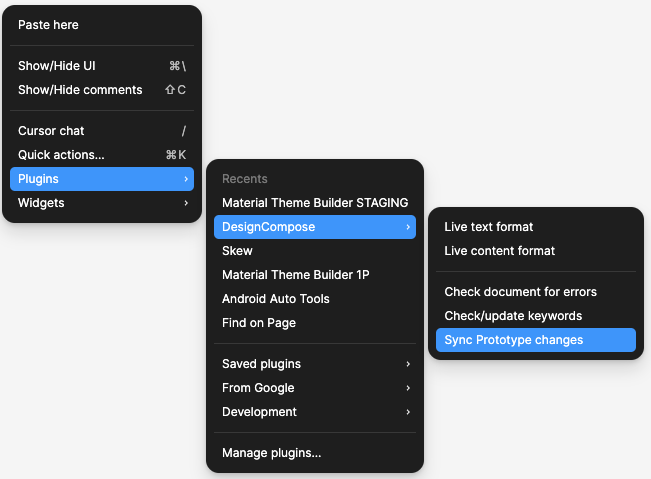Animations
Animations are supported in two different ways: animations from Figma interactions, and animations from programmatically changing variants.
Figma interaction animations
Animations set in Figma as a prototype interaction are supported. These animations run automatically whenever an interaction triggers the animation to begin. After making any changes to an interaction, make sure to run the Sync Prototype changes plugin so that the interaction is saved to the plugin data.

Variant change animations
When variants change programmatically using the @DesignVariant customization, they will use a default spring animation for the transition. This can be customized using the custom animation API by specifying an easing type, duration, and delay in the DesignDocSetting() function. Populate the new customVariantTransition parameter with a function that takes a VariantTransitionContext and returns an AnimationTransition interface. The context provides some data on variant that is changing, and the AnimationTransition needs two functions: animationSpec() that returns AnimationSpec<Float>, and delayMillis() that returns an Int representing the number of milliseconds to wait before beginning the animation. The SmartAnimateTransition is the only supported transition at this time. The easiest way to use this is to use a compose function such as androidx.compose.animation.core.tween, and optionally, the delay time in milliseconds.
Here is an example:
DesignDocSettings(
customVariantTransition = { context ->
if (context.fromComponentSet("MyComponentName")) {
SmartAnimateTransition(
tween(
durationMillis = (2f * 1000.0).roundToInt(),
easing = CubicBezierEasing(0.37f, 0f, 0.63f, 1f)
)
)
} else {
val mass = 1.0f
val stiffness = 20.0f
val critical = sqrt(4.0f * stiffness * mass)
val damping = 30.0f
SmartAnimateTransition(
spring(dampingRatio = damping / critical, stiffness = stiffness),
1000 // Delay by 1 second
)
}
}
)
We’re still working on the best way to identify the elements that are being animated. We added functions in VariantTransitionContext that use the node or component name, but this may change in the future.